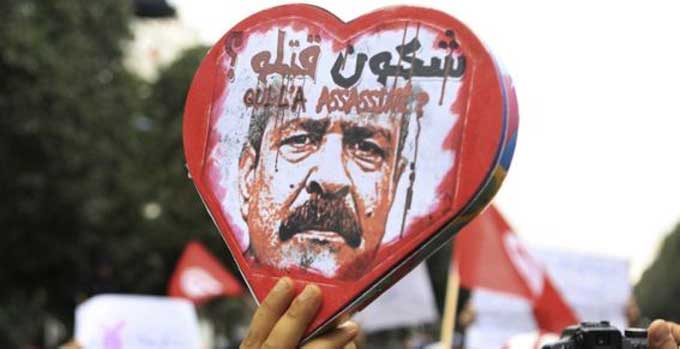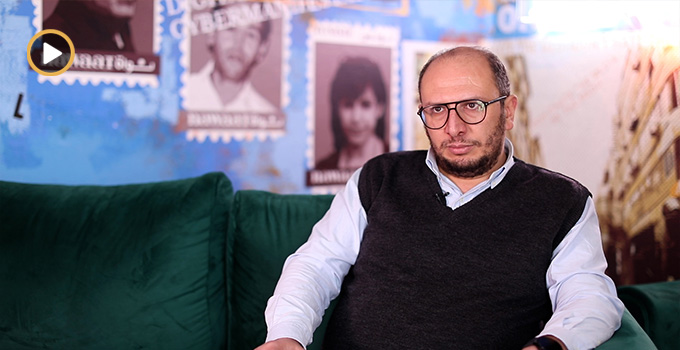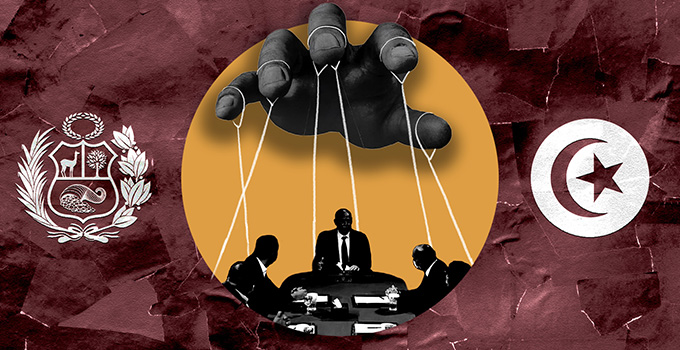
The facts are clear. The trial for the assassination of Chokri Belaid has been consistently postponed for a future date, not a single terrorist crime has been tried, and the attack in Sousse represents another window into political and security failures. Four years after the Rouhia case, it seems that the more insecurity has grown, the more opaque the security institution has become.
After the prevarications of Interior Minister Najem Gharsalli, Prime Minister Habib Essid elliptically confessed to the BBC that «the police was blocked everywhere». In spite of its gravity, the concession was more reasonable than «the hidden parties» which Gharsalli evoked. But Essid subsequently retracted his comment and indicated to La Presse that «National Guard agents who arrived by boat…intervened very early. They fired at the assailant, but did not reach him. To make matters worse, their rifle was jammed!» This version contradicts testimonies indicating that the agents in question «were afraid» and «did not want to confront the terrorist», and that it was «one of the hotel employees» who «took the weapon and aimed it at the terrorist. But not knowing how to use it, he stopped». Essid went so far as to risk making a comparison between the Sousse and Bardo attacks
Not to justify the delay in Sousse, but in Bardo the (police) headquarters is located just next to the Museum, whereas in order to reach the Port El-Kantaoui station, agents had to cross the entire city of Sousse on Friday at noon. Prime Minister Habib Essid
In other words, according to the Head of Government, when traffic is bad and the National Brigade of Rapid Intervention (Brigade nationale d’intervention rapide, BNIR) is not close by, disaster is inevitable.
Chain of Command
In contrast to the outlandish version recounted by the Prime Minister, Interior Ministry officials confided in Mediapart that normally «BNIR agents should have reached the area several minutes after the first call». They explain that «in the normal functioning of the chain of commandment of the national police, every urgent call from an on-site agent or Tunisian citizen is received by the local police station which transmits it for analysis to the operations room at the Ministry of the Interior. The analysis is relayed to the office of the General Directorate of National Safety in accordance with the legal provisions in place. The latter is responsible for alerting the General Directorate of Intervention Units which in turn orders the Counterterrorism branch to send the National Brigade of Rapid Intervention». According to Interior officials, such dysfunction is due to removal of the Director General of National Safety from this chain. Since February 2015, the responsibilities of this post have been absorbed by Secretary of State for Safety Rafik Chelly.

Here again the facts are clear. These shortcomings are not new to the security apparatus. But with important judicial decisions and reforms constantly deferred and the increasing intensity of terrorism, the Interior Minister has only become more opaque. We recall that 2013 already marked an escalation in political violence with a number of attacks against the police and army, and two political assassinations —Chokri Belaid and Mohamed Brahmi. Today, the terrorist scene is characterized by essentially the same failures and black holes. Already in 2013, the Initiative pour la recherche de la vérité sur l’assassinat de Chokri Belaid et Mohamed Brahmi (IRVA) had unveiled an internal document from the Interior Ministry proving that certain security officials had been warned of an assassination threat concerning deputy Mohamed Brahmi. Interior Minister Lofti Ben Jeddou therefore knew of the document although he maintained that he was not aware of it at the time. He subsequently explained that it was the standard procedure (sic). The Interior Ministry is also accused of having hidden the ballistic report concerning the assassination of Chokri Belaid. Similarly, according to the lawyers working on the case, Ahmed Rouissi and Kamel Gadhgadhi avoided sanctions since the vehicles they used were not searched the moment they were identified by the judicial police officer in charge of the investigation.
Failures or complicit passivity?
So what do we find in the Sousse attack? The same elements of a fallible security apparatus, particularly at the level of intelligence and prevention. How, for instance, do we explain police passivity in the case of 18 year-old Brahim who was sought to be recruited by certain unknown persons into the Sousse operation? Brahim’s aunt told Nawaat:
The people who approached my nephew came to get him in a car; they covered his eyes to bring him somewhere which must not be far from Jbel Khawi (close to Gammarth). They treated him aggressively and threatened to kill his little cousins to coerce him to carry a package from Tunis to another city by train, but he refused. Under pressure of harassment, he attempted suicide three days before the Sousse affair. He survived but said that he was prepared to try again. After he finally confessed all of this, we went to see the police who had mocked him. After the attack, the police came to search Brahim’s PC and assured us that he would be under protection.
Nawaat learned that on the same day, the imam of the mosque in Jbel Khawi was arrested. We recall that this imam had been expelled from the mosque when it was taken over by Salafists on 7 April 2013. Furthermore it seems that the Ministry of the Interior had been alerted in May that there would be a terrorist attack in Sousse, but that no action had been taken to prevent it. We attempted, in vain, to get in touch with the Ministry to verify this information.
The second killer wore a hood
Even more troubling are the testimonies of survivors (here and here) who confirm that the young man with the Kalashnikov was not the only one to act; until now the Interior Ministry has confirmed as much. Another assailant inside the hotel fired with a handgun. A British tourist «who was hiding next to the spa pool of the hotel», affirmed having seen «a man dressed in black, standing, hidden behind the stairwell, throughout the duration of the attack, who was either a look-out for the shooter or a security agent».
Operating on a victim wounded in the attack, a surgeon at Sahloul Hospital in Sousse observed that «the types of wounds were different, which might represent proof that the bullets are from different weapons». The Ministry of the Interior immediately denied this statement, estimating that «only the legal doctor and forensic specialists are qualified to make this [determination]», and that «the first elements of the investigation –in anticipation of the completion of the final report— show that all the bullets come from the same weapon».
The cell phone
Police secured the cell phone which Rezgui had thrown into the sea after having made a call and just before the shooting, one witness said. But again, survivors confided to the Daily Mail that after having opened fire on tourists, Rezgui «had stopped for a moment, rifle on his back, to take pictures of the bodies (of his victims), laughing». It is not a far stretch to deduce that the killer had two cell phones.
The question which one asks in this case is why the Imperial Marhaba, a five-star hotel, did not have surveillance cameras?
Rezgui was not a «lone wolf»
Initially «unknown by police services» according to the Interior Ministry spokesman, the author of the Sousse tragedy was in fact well-known within the leftist student union network. According to Ammani Sassi, president of the General Union of Tunisian Students (UGET), Rezgui directed an extremist cell that is currently active in Kairouan. The break-dancing Master’s student was therefore not, as Habib Essid maintained, a «lone wolf», but the recruit of a jihadist network well known by Tunisian, French, and American intelligence services. The attack carried out by Seiffedine Rezgui, alias Abu Yahya al-Qayrawani, and for which Daech claimed responsibility, leads to a training camp in Libya close to the city of Sabratha. It is there, confirmed in retrospect the Secretary of State for National Safety, that Rezgui trained with the two men responsible for the Bardo attack: the Tunisian Ahmed Rouissi and the French-Tunisian Aboubaker Al-Hakim. The former was killed in Syrte last March, and the latter —known to be the mentor of the Kouachi brothers who were responsible for the Charlie Hebdo attack- has presumably joined Daech in Syria.

The ramifications of this network lead to Kamel Gadhgadhi, Ali Harzi, and Abou Iyadh. The first, raised to the rank of emir by Ansar al-Charia leader Abou Iyadh, is a suspect in the assassinations of Chokri Belaid and Mohamed Brahmi, and in the ambush at Mount Chaambi in 2013. He was killed in 2014 during an antiterrorism operation in Raoued. Ali Harzi is implicated in the attack on the American embassy in Benghazi on 11 September 2012, and in the assassinations of Belaid and Brahmi. He was arrested and interrogated in 2013, and released for a lack of evidence. Several months later, Harzi went to Syria and then Iraq where his brother Tarek Harzi holds a high position in Daech. In 2015, Harzi was finally placed on the US State Department terrorist list which announced, 22 June 2014, his death in a drone strike in Mossoul. Recently, the Pentagon confirmed the death of his brother Tarek in an airstrike in Syria. There is also unconfirmed information indicating that Seifallah Ben Hassine, known as Abou Iyadh and accused of having led the attack on the American Embassy in Tunis in 2012, was killed last month in an American strike in Libya. This attack initially targeted Al-Qaida of the Islamic Maghreb (AQIM) leader Mokhtar Belmokhtar.
To this day, not one of these operations has been entirely brought to light, and not one suspect has been tried. In the meantime, more than 1,000 individuals have been imprisoned for planned acts of terrorism, according to the Interior Ministry spokesman. Faced with the security failures in Sousse, the government’s response was to dismiss several regional officers before declaring a state of emergency. Aside from the unconstitutionality of Article 8 of Decree 78-50 of 26 January 1978 which governs it, the state of emergency affords security forces extended powers. In the meantime, the investigation was assigned to the General Directorate for Combatting Terrorism within the National Guard, which prompts an important question: where are the judicial and security divisions (supposedly inaugurated in December 2014) in the fight against terrorism and money laundering?





iThere are no comments
Add yours